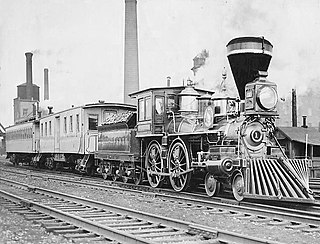
The William Crooks is a 4-4-0 steam locomotive that was the first locomotive to operate in the State of Minnesota, beginning in 1861. It was named after William Crooks, the Chief Mechanical Engineer for the St. Paul and Pacific Railroad. He served as a colonel and commander of the 6th Minnesota Volunteer Infantry Regiment during the American Civil War. Crooks laid the initial 10-mile (16 km) track between Minneapolis and St. Paul, and the William Crooks was the first locomotive to run on the line.
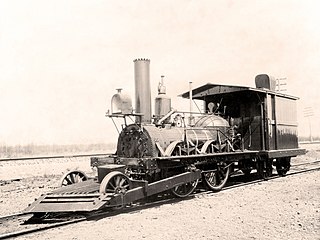
John Bull is a historic British-built railroad steam locomotive that operated in the United States. It was operated for the first time on September 15, 1831, and became the oldest operable steam locomotive in the world when the Smithsonian Institution ran it under its own steam in 1981. Built by Robert Stephenson and Company, it was initially purchased by and operated for the Camden and Amboy Railroad, the first railroad in New Jersey, which gave it the number 1 and its first name, "Stevens". The C&A used it heavily from 1833 until 1866, when it was removed from active service and placed in storage.
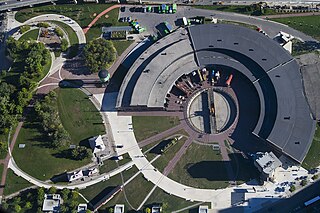
A railway roundhouse is a building with a circular or semicircular shape used by railways for servicing and storing locomotives. Traditionally, though not always the case today, these buildings surrounded or were adjacent to a turntable.
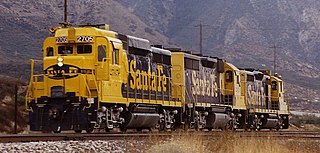
The EMD GP30 is a 2,250 hp (1,680 kW) four-axle diesel-electric locomotive built by General Motors Electro-Motive Division of La Grange, Illinois between July 1961 and November 1963. A total of 948 units were built for railroads in the United States and Canada, including 40 cabless B units for the Union Pacific Railroad.
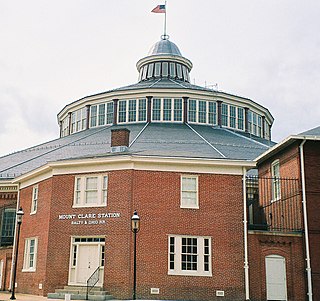
The B&O Railroad Museum is a museum and historic railway station exhibiting historic railroad equipment in Baltimore, Maryland. The Baltimore and Ohio Railroad (B&O) company originally opened the museum on July 4, 1953, with the name of the Baltimore & Ohio Transportation Museum. It has been called one of the most significant collections of railroad treasures in the world and has the largest collection of 19th-century locomotives in the U.S. The museum is located in the Baltimore and Ohio Railroad's old Mount Clare Station and adjacent roundhouse, and retains 40 acres of the B&O's sprawling Mount Clare Shops site, which is where, in 1829, the B&O began America's first railroad and is the oldest railroad manufacturing complex in the United States.

A camelback locomotive is a type of steam locomotive with the driving cab placed in the middle, astride the boiler. Camelbacks were fitted with wide fireboxes which would have severely restricted driver visibility from the normal cab location at the rear.

The EMD SW1 is a 600-horsepower (450 kW) diesel-electric switcher locomotive built by General Motors' Electro-Motive Corporation between December 1938 and November 1953. Final assembly was at EMD's plant at LaGrange (McCook) Illinois. The SW1 was the second generation of 3,402 cu in (55.75 L) switcher from EMD, succeeding the SC and SW. The most significant change from those earlier models was the use of an engine of EMD's own design, the then-new 567 engine, here in 600 hp (450 kW) V6 form. 661 locomotives of this design were built, with a gap in production between March 1943 and September 1945 due to World War II.

The Railroad Museum of Pennsylvania is a railroad museum in Strasburg, Lancaster County, Pennsylvania.

The Strasburg Rail Road is a heritage railroad and the oldest continuously operating standard-gauge railroad in the western hemisphere, as well as the oldest public utility in the Commonwealth of Pennsylvania. Chartered in 1832, the Strasburg Rail Road Company is today a heritage railroad offering excursion trains hauled by steam locomotives on 4.02 mi (6.47 km) of track in Pennsylvania Dutch Country, as well as providing contract railroad mechanical services, and freight service to area shippers. The railroad's headquarters are outside Strasburg, Pennsylvania.

Tom Thumb was the first American-built steam locomotive to operate on a common-carrier railroad. It was designed and constructed by Peter Cooper in 1829 to convince owners of the newly formed Baltimore and Ohio Railroad (B&O) to use steam engines; it was not intended to enter revenue service. It is especially remembered as a participant in a legendary race with a horse-drawn car, which the horse won after Tom Thumb suffered a mechanical failure. However, the demonstration was successful, and the railroad committed to the use of steam locomotion and held trials in the following year for a working engine.

Atlantic was the name of a very early American steam locomotive built by inventor and foundry owner Phineas Davis for the Baltimore and Ohio Railroad (B&O) in 1832. It is in fact the first commercially successful and practical American built locomotive and class prototype, and Davis' second constructed for the B&O, his first having won a design competition contest announced by the B&O in 1830.
A class of locomotives is a group of locomotives built to a common design, typically for a single railroad or railway. Often members of a particular class had detail variations between individual examples, and these could lead to subclasses. Sometimes technical alterations move a locomotive from one class to another. Different railways had different systems, and sometimes one railway used different systems at different times and for different purposes, or applied those classifications inconsistently. Sometimes therefore it is not clear where one class begins and another ends. The result is a classic example of the Lumper splitter problem.
On the Baltimore and Ohio Railroad, locomotives were always considered of great importance, and the railroad was involved in many experiments and innovations.

Norfolk and Western 475 is a 4-8-0 "Mastodon" type steam locomotive built by the Baldwin Locomotive Works in June 1906 as part of the Norfolk and Western Railway's (N&W) first order of M class numbered 375–499. It was first assigned to haul freight trains on the N&W mainline before being reassigned to branch line duties on the Blacksburg Branch in the 1920s.

The Baltimore and Ohio Ellicott City Station Museum in Ellicott City, Maryland, is the oldest remaining passenger railway station in the United States, and one of the oldest in the world. It was built in 1830 as the terminus of the Baltimore and Ohio Railroad line from Baltimore to the town then called Ellicott's Mills, and a facility to service steam locomotives at the end of the 13-mile (21 km) run. The station, a National Historic Landmark, is now used as a museum.

The Mason Machine Works was a machinery manufacturing company located in Taunton, Massachusetts, between 1845 and 1944. The company became famous for an early invention by its creator, William Mason, the self-acting mule, first patented in 1840. The company also later produced locomotives, rifles during the American Civil War, and later printing presses. However, the production of textile machinery would remain the company's core business during the late 19th century, until its decline in the 1920s.

The Mount Clare Shops is the oldest railroad manufacturing complex in the United States, located in Baltimore, Maryland. It was founded by the Baltimore and Ohio Railroad (B&O) in 1829. Mt. Clare was the site of many inventions and innovations in railroad technology. It is now the site of the B&O Railroad Museum. The museum and Mt. Clare station were designated a National Historic Landmark in 1961.

Pennsylvania Railroad No. 1223 is a class "D16sb" 4-4-0 "American" type steam locomotive built in November 1905 for the Pennsylvania Railroad by their own Altoona Works for passenger service. After being retired from active service in 1950, the locomotive ran excursion trains on the Strasburg Rail Road outside of Strasburg, Pennsylvania from 1965 to 1989 when it was removed from service requiring firebox repairs. Currently, the locomotive is still on static display at the Railroad Museum of Pennsylvania outside of Strasburg. It was listed on the National Register of Historic Places in 1979. No. 1223 is the only surviving example of the Pennsylvania Railroad's D16sb class.
Canadian Pacific 1278 is a class "G5d" 4-6-2 "Pacific" type steam locomotive built by the Canadian Locomotive Company for the Canadian Pacific Railway. After being retired from revenue service, the locomotive was purchased in 1965 by F. Nelson Blount for excursion trains at his Steamtown, U.S.A. collection. The locomotive was sold to Gettysburg Railroad in 1987, and it pulled excursion trains between Gettysburg and Biglerville, but it was subject to shoddy maintenance by inexperienced crews. The locomotive was retired from excursion service in 1995, after suffering a firebox explosion in June. As of 2024, the locomotive is on static display at the Age of Steam Roundhouse in Sugarcreek, Ohio.
Baltimore and Ohio No. 5300, also known as President Washington, is the sole survivor of the P-7 class 4-6-2 "Pacific" type steam locomotives. It was built by Baldwin in 1927, and it was used on mainline passenger trains across the Baltimore and Ohio system, particularly the Royal Blue train, until it was retired in 1957. After being stored for a few years, it was donated to the Baltimore and Ohio Railroad Museum in Baltimore, Maryland, where it has spent several years on static display. The locomotive is undergoing a cosmetic restoration, as of 2023.

















